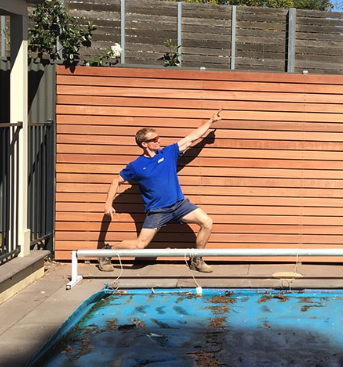How to Install Black Pool Fencing
Posted by Lee Benson on 15th Oct 2025
If you’re planning to install your own black pool fencing, you’ll be happy to know it’s a job you can tackle yourself with the right prep, tools and a bit of patience. And the result will be something you‘ll be proud of for many years to come. A sleek black finish on your pool fencing looks modern and stylish, while also complementing most common garden design styles and outdoor colour schemes.
At Outback Fencing, we’re purveyors of all things fencing – from kid-safe pool fencing to rural and boundary options – and we’re dedicated to helping every customer choose the right fence for the property, one that is the perfect balance of value, quality and style.
In this guide – which you can either watch through the video or read along in the blog below – we’ll walk through every step of the installation process, from setting up your string lines to securing your final panels and gates. So, if you’re upgrading existing pool fencing or starting from scratch, these tips will help you get a professional-looking result that’s safe, secure and built to last.
Tools and Materials You’ll Need to Install Black Pool Fencing
Before you start your black pool fencing installation, make sure you’ve got everything ready to go. Here’s what you’ll need:
Materials
- Pool fence panels (enough meterage to cover the fenceline)
- Posts
- Post caps
- Brackets and screws
- Concrete mix
- Gate materials – including hinges, latch and latch post
Tools
- Measuring tape
- String line and pegs
- Spirit level
- Spray paint or marker
- Post hole digger or double-hand shovel
- Wheelbarrow and shovel
- Drill and screwdriver bits
- Angle grinder or metal-cutting saw
- Safety gear
Step 1: Plan and Measure Your Pool Area
Before picking up a shovel or grabbing any fencing supplies, start by planning out the shape and layout of your fence. A well-laid-out plan is key to achieving a straight, neat finish.
Run string lines around the entire perimeter where your fence will go. These lines act as guides for where to dig your post holes and where the panels will sit. Make sure your lines are tight and level – use a spirit level to double-check.
If your pool is a unique shape, measure your diagonals to ensure the corners are square. For large areas, being a few millimetres off isn’t a big deal, it’s more about maintaining visual alignment.
Set the string line height to match where you want the bottom of the fence panel to sit, usually close to the ground, but with just enough clearance to avoid trapping debris or water.
Step 2: Mark Out the Post Locations
Once your string lines are in place, it’s time to mark where each post will go.
Start at a corner post and use a post cap or a spacer tool to measure the gap between each post. A handy trick is to make a simple spacer the exact width of your pool fencing panels (for example, 2450mm). Place your spacer between each post mark, spray a small dot or line on the ground, and continue all the way around.
Don’t forget to leave a few extra millimetres of space between panels to make installation easier later. This small gap allows for a bit of “play” when slotting in panels and helps prevent a too-tight fit.
If you have a gate to install, make sure to plan for it now. Gate openings will need a slightly larger gap to accommodate hinges and latches.
Step 3: Dig the Post Holes
Now it’s time to get your hands dirty. Using a double-hand shovel or post hole digger, dig holes roughly 200mm wide and 600mm deep for each post. If your soil is soft, a manual digger will do fine. For tougher ground, you can use an auger or hire a small digging machine – just be careful not to make the holes too wide, or you’ll end up using far more concrete than necessary. Once all holes are dug, clean out any loose soil or rocks so your posts can sit neatly and securely when it’s time to concrete them in.
Step 4: Set Your Posts in Concrete
With the holes ready, it’s time to concrete in your posts.
Measure your posts to ensure the height is consistent all the way around. Typically, a 1200mm post height is standard for pool fences, but double-check local regulations for your area. When pouring your concrete, stick to plain concrete mix rather than rapid-set. Rapid-set can generate heat as it cures and may damage aluminium posts. If you’re using a ready-mix concrete truck, ask them not to add accelerants or extra chemicals – a simple mix is best.
Drop each post into the hole and align it with your string line. Use a level to make sure it’s plumb (perfectly vertical) before the concrete begins to set. Continue this process around the entire pool. Once all posts are concreted, allow them to set overnight before attaching panels or gates.
Step 5: Prepare for Panel Installation
After the concrete has cured, your posts should feel solid and steady. Now you can move on to attaching your brackets and panels.
Start by unpacking your fence panels – they often come in bundles and may be wrapped in protective plastic to prevent scratches. Remove the packaging carefully to avoid damaging the coating.
Attach the top bracket to your post, just beneath the post cap, and fix it in place with a single screw. This allows you to make small adjustments later before locking it all down. Once the first bracket is attached, fit your panel into position, then add a bracket on the opposite post. Line it up evenly and secure it with another screw.
Work your way around the entire pool, adding panels one at a time. A good tip is to secure the top brackets first, leaving the bottoms loose until you’ve checked that your fence line looks straight and level. Once you’re happy with the alignment, tighten everything up and finish off the bottom brackets.
Step 6: Install the Pool Gate
Now, for the practical part of your pool fencing, the gate. Getting this part right is essential for safety and compliance.
Standard pool gates are around 975mm wide, but you’ll need to allow extra space for hinges and latches – usually an additional 20mm on each side. That means your total gate opening should be approximately 1015mm between posts.
When positioning your gate posts, keep pool safety and compliance in mind. The latch must be at least 1.5 metres above ground level so that young children can’t reach it. And remember, your pool gate must open away from the pool area to comply with safety regulations. Fit the hinges and latch according to the manufacturer’s instructions, making sure the gate swings smoothly and self-closes securely.
Step 7: Tackle Tricky Spots and Small Panels
Sometimes, your layout won’t perfectly match the standard panel sizes, and you’ll need to cut a smaller section. In this case, measure the space between your posts and mark where you need to trim the panel. Use a thin cutting disc or angle grinder for a clean, straight cut.
If a post happens to land right where your bracket needs to go, cut slightly from both ends of the panel rather than all from one side. This helps maintain symmetry and gives you enough room to attach brackets properly.
Always double-check measurements before cutting. It’s better to measure twice and cut once than risk wasting a panel.
Step 8: Final Checks and Finishing Touches
Once all panels and the gate are installed, go around the entire fence line and make sure everything is level and secure.
Add the final screws through the bottom of each bracket to lock the panels firmly in place. This step helps prevent any movement and strengthens the connection between your posts and panels. Step back and take a look at your finished fence (it should have a consistent height, straight lines and a lovely, clean finish).
Maintaining Your Pool Fence
To keep your fence looking great and functioning properly, it’s important to clean and maintain your pool fencing regularly. Wash it down every few months with mild soapy water to remove dirt, salt and chlorine residue. You can just use detergent here and avoid harsh chemicals that could damage the powder coating.
If you live in a coastal or regional area, these are areas that often come with a more demanding environment for aluminium, so make sure you add your pool fence to your low-maintenance garden design plan. A quick rinse after storms or windy days can help prevent corrosion and keep your fence looking new for years.
Why Black Pool Fencing Works in Any Backyard
One of the best things about black fencing is its timeless appeal. It suits modern and classic pool fencing ideas alike, providing a subtle frame that doesn’t distract from your pool or garden.
Black also contrasts beautifully against green lawns, timber decks, sparse and low effort gardens or paved courtyards – perfect for homeowners who value the art of functional landscaping. For those living outside urban areas, a smart, durable pool fence can even boost the value of your rural property while tying in with broader landscaping tips for regional homes.
Packing Up
Installing your own pool fencing is a hugely satisfying weekend project as well as a way to create a safer, more stylish outdoor space that enhances the overall look of your home. With careful planning, a few essential tools and attention to detail, you can get a clean, professional finish that will last for years. Even if you’re just learning the ropes and doing it yourself for the first time, this guide gives you everything you need to get started on your new black pool fencing installation with confidence.


